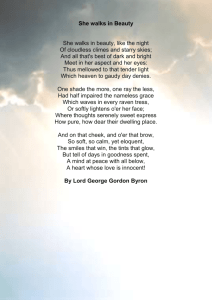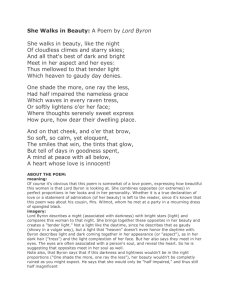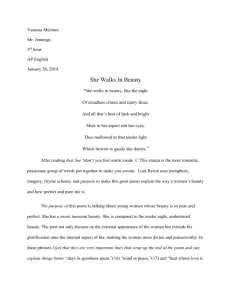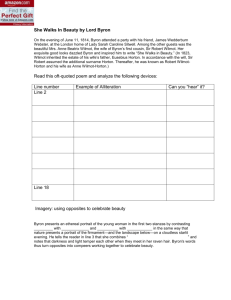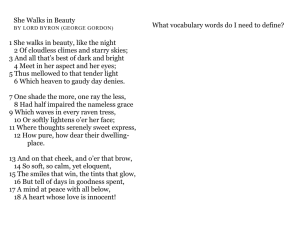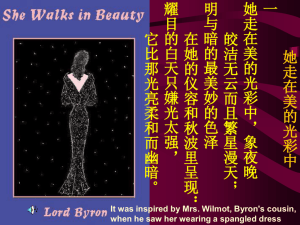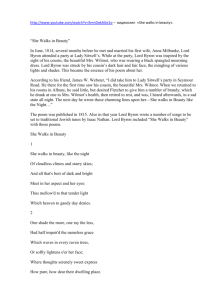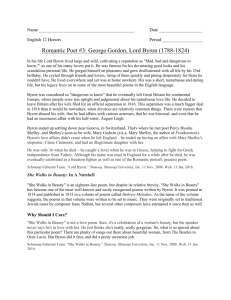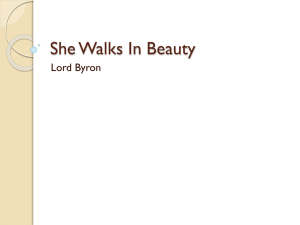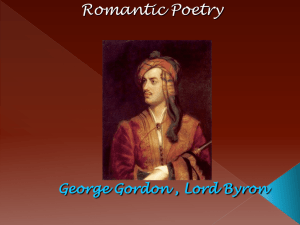She Walks in Beauty
advertisement
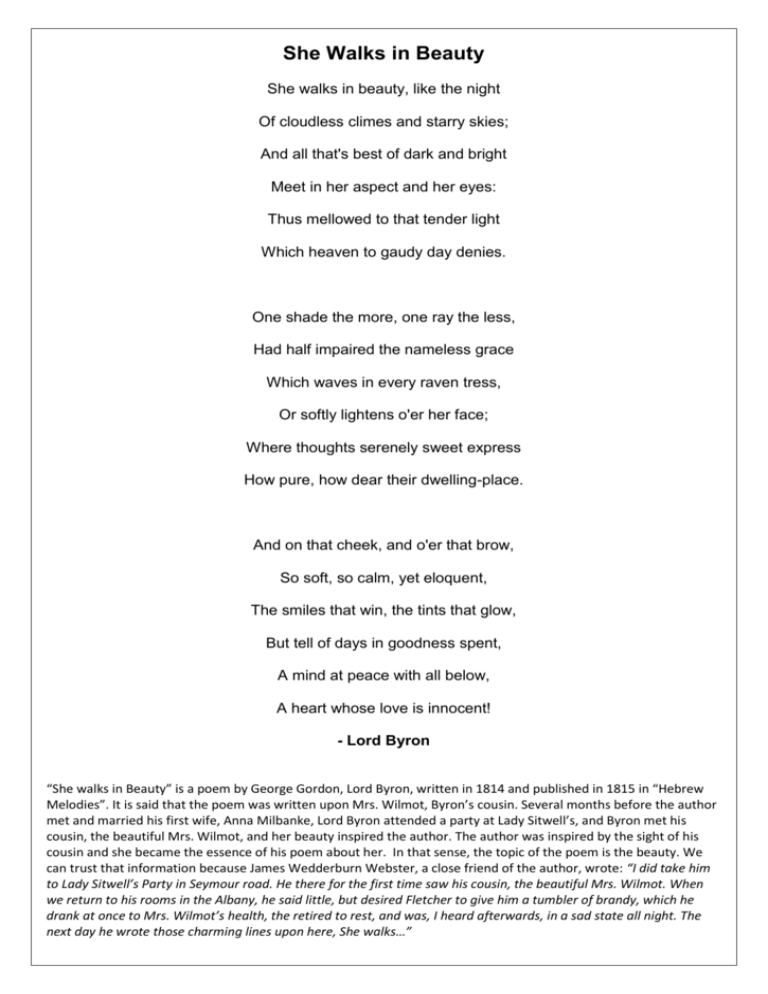
She Walks in Beauty She walks in beauty, like the night Of cloudless climes and starry skies; And all that's best of dark and bright Meet in her aspect and her eyes: Thus mellowed to that tender light Which heaven to gaudy day denies. One shade the more, one ray the less, Had half impaired the nameless grace Which waves in every raven tress, Or softly lightens o'er her face; Where thoughts serenely sweet express How pure, how dear their dwelling-place. And on that cheek, and o'er that brow, So soft, so calm, yet eloquent, The smiles that win, the tints that glow, But tell of days in goodness spent, A mind at peace with all below, A heart whose love is innocent! - Lord Byron “She walks in Beauty” is a poem by George Gordon, Lord Byron, written in 1814 and published in 1815 in “Hebrew Melodies”. It is said that the poem was written upon Mrs. Wilmot, Byron’s cousin. Several months before the author met and married his first wife, Anna Milbanke, Lord Byron attended a party at Lady Sitwell’s, and Byron met his cousin, the beautiful Mrs. Wilmot, and her beauty inspired the author. The author was inspired by the sight of his cousin and she became the essence of his poem about her. In that sense, the topic of the poem is the beauty. We can trust that information because James Wedderburn Webster, a close friend of the author, wrote: “I did take him to Lady Sitwell’s Party in Seymour road. He there for the first time saw his cousin, the beautiful Mrs. Wilmot. When we return to his rooms in the Albany, he said little, but desired Fletcher to give him a tumbler of brandy, which he drank at once to Mrs. Wilmot’s health, the retired to rest, and was, I heard afterwards, in a sad state all night. The next day he wrote those charming lines upon here, She walks…” Rhyme Scheme and Meter The rhyme scheme of the first stanza is ababab; the second stanza, cdcdcd; and the third stanza, efefef. The meter is predominantly iambic tetrameter, a pattern in which a line has four pairs of unstressed and stressed syllables—eight syllables in all. The first two lines demonstrate the pattern followed throughout the poem except for line 6, which has nine syllables: 1................2........... 3...............4 She WALKS | in BEAU | ty, LIKE | the NIGHT 1.................2................. 3...............4 Of CLOUD | less CLIMES | and STAR | ry SKIES Enjambment Enjambment links the end of line 1 with line 2. Enjambment means carrying the sense of one line of verse over to the next line without a pause. (Note that there is no pause after night. Pauses occur at the end of the other lines.) Use of Alliteration Alliteration occurs frequently to enhance the appeal of the poem to the ear. The most obvious examples of this figure of speech include the following: Line 2:....cloudless climes; starry skies. Line 6:....day denies Line 8:....Had half Line 9:....Which waves Line 11...serenely sweet Line 14...So soft, so Line 18...Heart Whose Other Figures of Speech Examples of other figures of speech are the following: Lines 1, 2:......Simile comparing the movement of the beautiful woman to the movement of the skies Lines 8-10:......Metaphor comparing grace, a quality, to a perceivable phenomenon Lines 11-12:....Metaphor and personification comparing thoughts to people; metaphor and personification comparing the mind to a home (dwelling-place) Lines 13-16:....Metaphor and personification comparing the woman's cheek and brow to persons who tell of days in goodness spent Imagery: Light and Darkness Byron presents an ethereal portrait of the young woman in the first two stanzas by contrasting white with black and light with shadow in the same way that nature presents a portrait of the firmament—and the landscape below—on a cloudless starlit evening. He tells the reader in line 3 that she combines “the best of dark and bright” (bright here serving as a noun rather than an adjective) and notes that darkness and light temper each other when they meet in her raven hair. Byron's words thus turn opposites into compeers working together to celebrate beauty. Study Questions 1. What is beauty? To what extent does beauty depend on personality? 2. Was Byron declaring his love for the young woman or simply celebrating her beauty? 3. The poem emphasizes that the woman's beauty has to do with the harmonious blending of light and dark in her features. Does the speaker believe one better than the other? Why or why not, and how can you tell? What do you think? 4. Why does the poet compare the woman to "night" instead of to "day"? 5. Most critics believe that the woman described in this poem is Byron's cousin by marriage, Lady Wilmot Horton, whom he met at a party the night before writing this piece. If that's true, why doesn't he mention his subject by name? Does your interpretation of the poem change, knowing that it may have been inspired by a specific woman? How so? 6. Write a poem about a quality—strength, generosity, kindness, beauty, charm, selflessness, etc.

